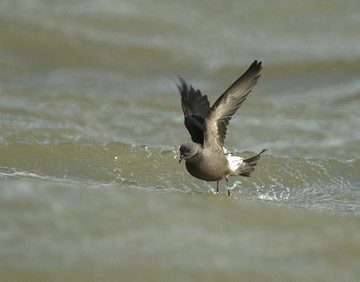Leach’s Petrel (Oceanodroma leucorhoa)

Leach’s Petrel © Sue & Andy Tranter
It had seemed unlikely that this species would feature in this Atlas other than as the logo of CAWOS, but the weather of November/ December 2006 changed that.
Leach’s Petrels migrate west of Ireland between their breeding sites, on remote islands off Scotland and Iceland, and wintering areas thought to include the Bay of Biscay and farther south in the Atlantic as far as the equator. They feed on marine macro-zooplankton – especially lanternfishes and crustaceans including krill – that are forced close to the ocean surface by upwelling along the steep edge of the continental shelf. Their preferred habitat is thus way offshore over deep oceanic water, from 200 m to 2,000 m deep, but north-westerly gales in September and October drive some birds into the Irish Sea and some of these reach the mouth of the Mersey, the north Wirral coast and Hilbre. This offers the only opportunity for many birdwatchers to see this most pelagic of species, and many visit the Wirral at such times. This passage is over by the end of October, and usually before.
However, in mid-November 2006 gale-force south-westerly winds apparently blew some Leach’s Petrels back north from their wintering areas into the Irish Sea. Seven were seen flying past Hilbre Island on 21 November when the winds changed to north‑westerly and brought some birds inshore. Winds remained southerly into early December when a severe gale on 3 December blew many more petrels into the Irish Sea. Birds were reported from many south-westerly facing coasts but only one, on 6 December, from our area. Then, winds veering north-westerly again forced Leach’s Petrels near to the north Wirral coast and counts totalling 25 and 78 were made on 8 and 9 December. One was blown inland and seen on Radnor Mere on 10 December, and single birds were recorded on the north Wirral on 10 and 11 December, then this remarkable event was over (Smith 2007).
These birds that are blown off-course are often doomed to die, although some Leach’s Petrels can apparently survive in the shallow inshore waters off our coasts, possibly finding edible items at the sea-surface such as molluscs, offal and other detritus by using their sense of smell as well as sight. One was reported freshly dead in West Kirby on 12 December, but it is not known how many other dead petrels were found in December 2006.
The rarity of this incident is indicated by there being only three or four previous winter records of single birds in our area. On 8 December 1886 in Chester and 16 December 1907 in Ellesmere Port, birds were found sick or dead, and Boyd (1946) saw one swimming and flying on Marbury Mere (Great Budworth) on 26 December 1942. The BTO Winter Atlas of 1981/ 82, 1982/ 83 and 1983/ 84 included one bird seen in the 10-km square SJ39, spanning Cheshire and Wirral and Merseyside.
Sponsored by Hilbre Bird Observatory and Ringing Station

